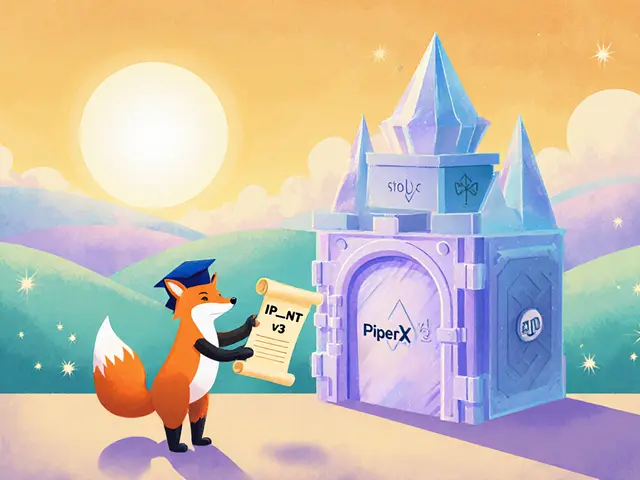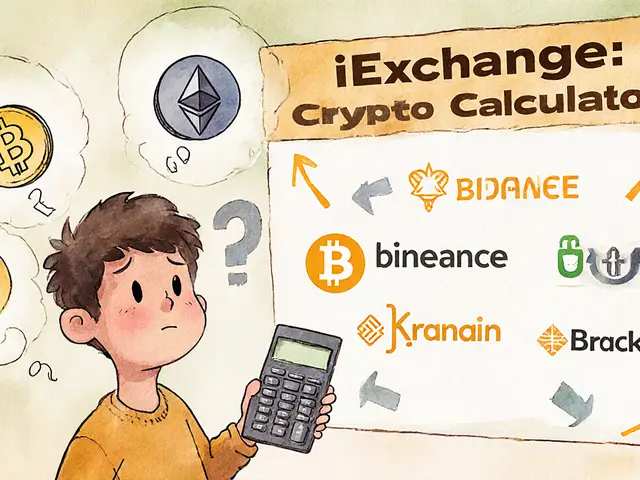PiperX v3 vs DEX Comparison Calculator
PiperX v3 is designed for IP-backed tokens, while mainstream DEXes like Uniswap and PancakeSwap serve general-purpose assets. Understanding their differences helps determine which platform suits your needs.
| Feature | PiperX v3 | Uniswap (V3) | PancakeSwap |
|---|---|---|---|
| Primary Asset Class | IP-backed tokens | ERC-20 / ERC-721 | BNB-based tokens |
| Liquidity Model | Custom bonding curve + CreativityProof | Concentrated liquidity | Standard AMM |
| Typical Slippage ($10k pool) | Sub-0.5% | 0.05% - 0.3% | 0.1% - 0.5% |
| Fee Structure | Dynamic (0.15% - 0.3%) | 0.05% - 0.3% | 0.25% |
| LP Allocation | 70% to LPs | 100% to LPs | 100% to LPs |
Customize how you'd like to evaluate these platforms based on your priorities:
Recommended Platform Based on Your Criteria
Quick Takeaways
- PiperX v3 is an AMM DEX built on the Story blockchain that targets IP‑backed tokens.
- It uses proprietary CreativeProof and DeFAI Agent tech to lower slippage and offer yield farming based on IP creation metrics.
- Fees are dynamic (0.15‑0.3%) with 70% routed to liquidity providers.
- Currently pre‑mainnet - TVL and trading volume are $0, with launch aimed for Q12026.
- Best suited for IP creators and developers comfortable with Story Protocol; not a replacement for general‑purpose DEXs like Uniswap.
What Is PiperX v3?
PiperX v3 is an Automated Market Maker (AMM) decentralized exchange designed specifically for intellectual property‑backed tokens. It runs on the Story blockchain and forms the liquidity layer of the broader IPFi ecosystem.
The platform was born out of the Story Protocol team, which wanted to solve the “liquidity problem” for real‑world IP assets that have been tokenized on‑chain.
How the IPFi Model Works
IPFi stands for Intellectual Property Finance. In this model, creators mint an IP‑NFT that represents ownership or usage rights to a piece of intellectual property-music, patents, art, etc. The token follows the Story protocol’s IP‑NFT standard, which embeds metadata verified by AI agents. The token can then be deposited into PiperX v3’s liquidity pools, allowing anyone to trade the IP‑NFT for Story’s native token or other crypto assets.
Because the assets are often low‑liquidity and niche, PiperX v3’s bonding curve and CreativityProof technology aim to keep slippage under 0.5% even when the pool holds less than $10,000 worth of an IP token.
Key Technical Features
- CreativityProof: a patent‑pending yield‑farming module that rewards liquidity providers based on the creator’s IP‑creation metrics rather than pure capital contributed.
- DeFAI Agent infrastructure: AI agents act as autonomous market participants, matching buy‑sell orders and verifying IP metadata on‑chain.
- Custom bonding curve algorithm: reduces price impact for low‑liquidity assets, targeting sub‑0.5% slippage.
- EVM‑compatible wallet support: users can connect MetaMask, Coinbase Wallet, or any Story‑compatible Web3 extension.
- Story‑Protocol SDK≥2.3 required: developers need the latest SDK to interact with the IP‑NFT standard and DeFAI agents.

Fee Structure & Incentives
PiperX v3 does not charge a flat trading fee. Instead, it applies a dynamic protocol fee ranging from 0.15% to 0.3% depending on the depth of liquidity in a given pool. The split is:
- 70% of fees go directly to liquidity providers as additional IP‑token yield.
- 30% is retained in the protocol treasury to fund IP ecosystem development, legal compliance work, and future upgrades.
This model is intended to align incentives for creators (who earn extra yield when their IP gets traded) and investors (who receive a share of the protocol’s growth).
How PiperX v3 Stacks Up Against Mainstream DEXs
| Feature | PiperX v3 | Uniswap (V3) | PancakeSwap |
|---|---|---|---|
| Primary Asset Class | IP‑backed tokens | ERC‑20 / ERC‑721 | BNB‑based tokens |
| Liquidity Model | Custom bonding curve + CreativityProof | Concentrated liquidity | Standard AMM |
| Typical Slippage ( < $10k pool ) | <0.5% | 2‑5% | 2‑5% |
| Dynamic Fee Range | 0.15‑0.3% | 0.05‑0.3% (user‑set) | 0.2% flat |
| TVL (Sept2025) | $0 (pre‑mainnet) | $142B monthly | $89B monthly |
| Target Users | IP creators, developers, specialized investors | General crypto traders | General crypto traders |
The table shows why PiperX v3 isn’t a direct competitor to big‑ticket DEXs. Its niche focus gives it a technical edge for IP assets but also limits its addressable market until tokenized IP gains traction.
Current Status, Risks, and Regulatory Landscape
As of October92025, PiperX v3 is still on testnet. Official metrics list $0 total value locked, $0 trading volume, and zero mainnet days. The roadmap promises a mainnet launch in Q12026, but several risk factors remain:
- Technology risk: The platform relies on the Story blockchain’s AI‑agent consensus, which has not yet proven itself at scale.
- Adoption risk: IP creators must first tokenise their works and trust on‑chain metadata. Early surveys show only about 12% of IP lawyers expect meaningful blockchain adoption before 2027.
- Regulatory risk: The SEC’s September2025 guidance treats many IP‑backed tokens as potential securities, meaning future compliance costs could rise.
- Liquidity risk: Even with a low‑slippage bonding curve, a thin pool can still suffer severe price swings if large trades occur.
These concerns are echoed by analysts at Messari, The Block, and Decrypt, who label PiperX v3 as “high‑risk, high‑reward.”
Who Might Benefit From PiperX v3?
If you’re an IP creator (musician, filmmaker, patent holder) looking to unlock early‑stage financing without selling outright, PiperX v3’s yield‑farming model could provide a novel revenue stream. Developers building on Story Protocol will also find the DeFAI Agent infrastructure useful for automating IP‑related trades.
Conversely, if you’re a casual crypto trader focused on high‑volume token swaps, you’ll likely get better pricing and deeper liquidity on Uniswap, Sushiswap, or PancakeSwap.

Getting Started (Testnet Walkthrough)
- Install a Web3 wallet (MetaMask recommended) and connect it to the Story testnet RPC endpoint.
- Visit the Story Protocol dashboard and create an IP‑NFT by uploading your IP metadata and signing the transaction.
- Navigate to the PiperX v3 UI, click “Add Liquidity,” and select the newly minted IP‑NFT paired with STORY token.
- Configure the DeFAI Agent settings - choose an AI agent profile that matches your asset’s risk tolerance.
- Confirm the transaction, wait for the pool to be created, and then you can start swapping or staking via the CreativityProof module.
The entire flow can take 40‑60hours for users unfamiliar with blockchain and IP law, according to community feedback.
Pros & Cons at a Glance
| Pros | Cons |
|---|---|
| Specialized liquidity for IP assets | Pre‑mainnet, no real TVL yet |
| Low slippage thanks to custom bonding curve | Heavy technical onboarding |
| Dynamic fee model aligns incentives | Regulatory uncertainty around IP‑tokens |
| AI‑agent driven order matching | Dependence on Story blockchain’s unproven consensus |
Future Outlook
Assuming a successful mainnet launch in early2026, PiperX v3’s growth hinges on two parallel tracks:
- IP tokenization adoption: If major publishers, studios, or patent offices start issuing IP‑NFTs, the platform could see a rapid influx of liquidity.
- Story blockchain maturity: Improvements to the AI agent consensus and integration with other Layer‑1 ecosystems would boost confidence among developers and investors.
Analysts at Framework Ventures forecast that IPFi could capture up to 20% of DeFi TVL within five years under an optimistic adoption scenario, while Delphi Digital places the probability of $100M annual volume by 2028 at roughly 35%.
In short, PiperX v3 offers a bold vision for bridging real‑world IP value to DeFi, but the execution risk remains high. Keep an eye on the Q12026 mainnet rollout and any partnership announcements with music publishers or patent firms - those will be the true catalysts.
Frequently Asked Questions
When is PiperX v3 expected to go live on mainnet?
The official roadmap lists a Q12026 mainnet launch, though the exact date depends on final Story blockchain upgrades and successful IP‑NFT integrations.
What types of assets can I trade on PiperX v3?
Only tokens that follow the Story protocol’s IP‑NFT standard are supported. This includes music copyrights, patents, visual art NFTs, and other tokenized intellectual property.
How does the fee model differ from Uniswap?
PiperX v3 uses a dynamic fee ranging from 0.15% to 0.3% based on pool liquidity depth, while Uniswap V3 lets liquidity providers set a fee tier (0.05%, 0.30%, or 1%). PiperX also splits fees 70/30 between LPs and the treasury.
Do I need the Story Protocol SDK to use PiperX v3?
Yes, the platform requires Story Protocol SDK version2.3 or higher to interact with the IP‑NFT standard and DeFAI agents.
Is PiperX v3 safe from a security standpoint?
Security depends largely on the underlying Story blockchain and its AI‑agent consensus. As of now, there have been no public audits of PiperX’s smart contracts, so users should treat the platform as experimental.









Laura Herrelop
October 10, 2025 AT 02:39Nisha Sharmal
October 11, 2025 AT 00:16Karla Alcantara
October 11, 2025 AT 13:36Also, if anyone wants to collaborate on an IP-NFT for a protest song I wrote, hit me up. Let's make this real.
Jessica Smith
October 11, 2025 AT 13:53Petrina Baldwin
October 12, 2025 AT 08:46Ralph Nicolay
October 12, 2025 AT 20:51sundar M
October 13, 2025 AT 03:56Nick Carey
October 13, 2025 AT 04:12Sonu Singh
October 13, 2025 AT 18:07